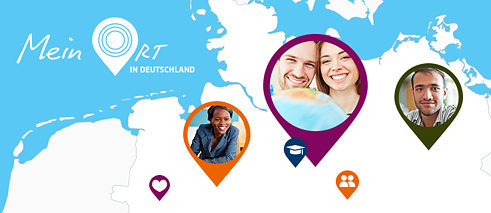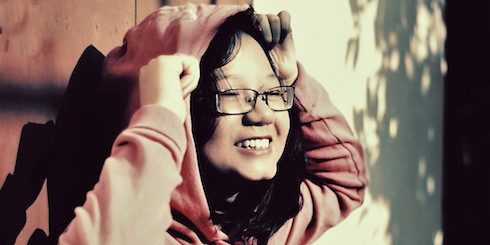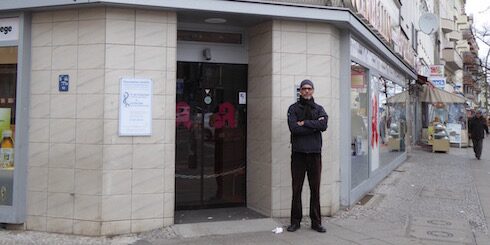Audience Award
Mein Ort in Deutschland

A love story from Augsburg won the audience award of the international competition “Mein Ort in Deutschland.” The Goethe-Institut asked people to divulge their favourite places in Germany online, drawing 1,200 stories from 100 countries. We present three of these places here: the university library in Augsburg, a street corner in Berlin-Neukölln and a park in the Black Forest that is dedicated to timepieces.
Since the launch of “Mein Ort in Deutschland” in February 2016, people who were not born in Germany could submit essays in German or their native languages. They are pinpointed on an interactive map of Germany on the website. An expert jury of six people from the arts, academia and politics chose the ten most outstanding essays. In the ensuing online vote, the audience was asked to choose their favourites and therefore decide the main prize.
Johannes Ebert, the secretary-general of the Goethe-Institut and a member of the jury, said, “We were very delighted with the numerous and original competition entries. They demonstrate the great interest in our country in a wide variety of facets. The looks from around the world at places in Germany are marked by sympathy and affection; they reflect the history and present of Germany and foster new perspectives on places familiar to us. I warmly congratulate the winner of the audience award on behalf of the Goethe-Institut and wish her many more pleasant experiences in Germany.” Dieu Linh Bui won the audience award via online votes. She will receive a one-week trip to Germany for two to the place of her choice. All of the final texts are available to read on the project website.
“How did you find me?” by Dieu Linh Bui from Vietnam
 Dieu Linh Bui | Photo: private
“In the library at Augsburg Uni there is a seat by the window. The sun used to shine there every morning. It was certainly an ideal seat for me when I didn’t yet have any friends at the start of my stay in Germany. Augsburg in autumn was cooler than South-East Asia. I wanted to sit in the sun because I felt a bit cold, even though I had already put on my jumper. One day a boy came to me. He asked me if I could share the seat with him. I agreed and carried on reading my favourite book. We sat quietly together like that. One day after the next. At lunch it was noisy and cool inside the canteen. So I always ate on the terrace where it was warm and there weren’t too many people.
Dieu Linh Bui | Photo: private
“In the library at Augsburg Uni there is a seat by the window. The sun used to shine there every morning. It was certainly an ideal seat for me when I didn’t yet have any friends at the start of my stay in Germany. Augsburg in autumn was cooler than South-East Asia. I wanted to sit in the sun because I felt a bit cold, even though I had already put on my jumper. One day a boy came to me. He asked me if I could share the seat with him. I agreed and carried on reading my favourite book. We sat quietly together like that. One day after the next. At lunch it was noisy and cool inside the canteen. So I always ate on the terrace where it was warm and there weren’t too many people.Suddenly he came up to my dining table. I was very surprised and asked him: ‘How did you find me here?‘ ‘It’s quite simple! I looked where the sun was shining‘ – He looked at me. His beaming smile was like sunshine and made my heart warmer. We could understand each other very well even before I spoke. This moment is so sweet that I sometimes wish I could stop time and fly to Augsburg so that we can get to know each other again.”
“The Death of ‘Abenteurer‘ Mackay” by Paul Diamond from New Zealand
 Paul Diamond in front of the Werbellin Apotheke in Berlin | Photo: private
“A street corner in Neukölln is special to me because it’s where a New Zealander was killed in 1929. Charles Mackay was shot by a police sniper while reporting for a British newspaper on the May Day riots between communists and police. Mackay came to Berlin after causing a sensation in Whanganui, a large town where he was the Mayor. In 1920 he shot a blackmailer, who threatened to reveal Mackay’s homosexuality unless he resigned. The blackmailer survived, and Mackay went to prison for attempted murder, but was released after 6 years, on condition he leaves New Zealand. Mackay travelled to London, and arrived in Berlin in 1928.
Paul Diamond in front of the Werbellin Apotheke in Berlin | Photo: private
“A street corner in Neukölln is special to me because it’s where a New Zealander was killed in 1929. Charles Mackay was shot by a police sniper while reporting for a British newspaper on the May Day riots between communists and police. Mackay came to Berlin after causing a sensation in Whanganui, a large town where he was the Mayor. In 1920 he shot a blackmailer, who threatened to reveal Mackay’s homosexuality unless he resigned. The blackmailer survived, and Mackay went to prison for attempted murder, but was released after 6 years, on condition he leaves New Zealand. Mackay travelled to London, and arrived in Berlin in 1928.Both cities attracted homosexual men, but it’s not known whether this was a motivation for Mackay. Obituaries published in Berlin described him as an Abenteurer, an adventurous man, and a Weltenbummler, a world traveler. Whenever I visit Berlin, I try to visit the nondescript spot outside the Werbellin Apotheke, where the Abenteurer Herr Mackay’s adventurous life ended.”
“Chronoculture” by Valentín Di Leone Xavier from Uruguay
If we Uruguayans are unpunctual, then the rest of the world is surely no different, is it? That was what I thought until I started a German course four years ago and became familiar with a punctual culture. I also told my teacher there that there is a park in Germany dedicated to timepieces, the ‘Eble Uhren Park‘ (a park like that could never exist in Uruguay). An amazing place, because of what it is, and because of its origin (as it was founded by a family of clockmakers). Maybe this family shared my mission and was successful with it?”
Teaching materials
You can use these materials to link the “Mein Ort in Deutschland” with your lessons.- UE 1 for students of German at level A2/B1, approx. 45 minutes with exercises for reading comprehension, vocabulary activation for describing places, and guidance for working with content relating to the post themes)
- UE 2 for advanced students of German level B1 and above, approx. 45 minutes (building on UE 1) with advanced exercises to improve reading comprehension and introduction to independent creative composition of posts
Documents to download
Mein Ort in Deutschland
“Mein Ort in Deutschland” is a project by the Goethe-Institut in cooperation with Hueber Verlag. The project set-up of “Mein Ort in Deutschland” was made possible by funds from the Bildungsoffensive Deutsche Sprache of the German Foreign Office. The 80 most exciting and original stories will be published as a book this October in cooperation with Hueber Verlag.